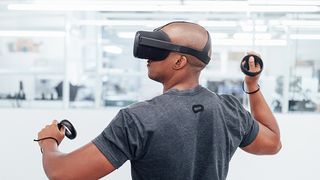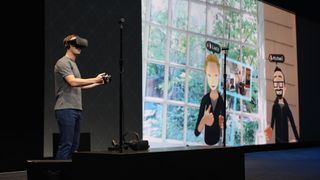Oculus Rift 2: the VR headset that never was
The canceled Rift 2 may never see the light of day

There was a time when the Oculus Rift 2 seemed like it would really push the limits of a next-gen VR headset – and possibly even take on the HTC Vive, which still leads with its superior room-scale tracking. But with the departure of former CEO Brendan Iribe, and its owner Facebook's apparent enthusiasm to stick with mid-range hardware, it doesn't look like a super-powered Oculus Rift sequel is on its way.
What we did get was the Oculus Rift S: a small upgrade on the existing hardware at the Rift's previous price point. Oculus has its eyes firmly on a particular price bracket, and it doesn't seem to be budging.
- Check out our original Oculus Rift review
The Rift S opted for slightly enhanced visuals and processing, without the need for an external sensor, though still required a wired connection to a high-end PC, and didn't really distinguish too much from its predecessor.
The standalone Oculus Quest headset seems to carry the company's hopes: as a wireless VR headset that will be more palatable to a casual gaming and gadget audience.
It's not like Oculus has given up on advancing its technology: far from it! 2019 has seen a number of updates to bring a Amazon Prime Video VR app to its platform, while increasing the accuracy of its hand-tracking in the Quest and Rift S. The Quest will also soon be able to emulate Oculus Go games and work with its older controllers too.
What's more, the tide in usage seems to be turning in the Oculus Rift's favor, at least according to the most recent Steam hardware survey.
But will we ever see an Oculus Rift 2? It may live forever as a placeholder name for Oculus' succession of small enhancements, without ever really justifying the big number. It's also possible that we've seen it already: with four distinct Oculus headsets on the market, what else are we really asking for here?
Get daily insight, inspiration and deals in your inbox
Get the hottest deals available in your inbox plus news, reviews, opinion, analysis and more from the TechRadar team.
Here you'll find all the rumors currently doing the rounds about a potential Oculus Rift successor – and what we'd want to see in an official Rift 2.
- Oculus Rift S vs Rift vs Quest: which headset comes out on top?
Cut to the chase
- What is it? A potential follow-up to the Oculus Rift VR headset
- When is it out? No hardware has yet been announced
- What will it cost? Facebook has been capping its headsets at $399 (around £320 / AU$570) so far, but an advanced model could inch above that
Release date
With no official announcement about the release of Oculus Rift 2 yet, it's unclear when we're going to see a sizeable upgrade to Facebook's VR headset (Facebook owns Oculus), if we ever will.
VR is still a nascent industry, so there's been speculation about which update model Oculus, and the industry in general, will follow – it could be something like the phone model, with yearly updates, or something closer to the console model, with updates every six years or so. And manufacturers are still figuring this out.
But with HTC Vive and HTC Vive Pro comfortably filling the premium end of consumer VR, Oculus will need to move soon if it doesn't want to give away this ground entirely. It's fully possible, though, that Oculus will continue working on mid-range hardware, and actually away from the wired Rift models entirely, in the hopes of gaining more mass-market success.

Price
Just like everything else about the headset, the Oculus Rift 2 price is an unknown. Our best guess is that it won't be too much more expensive than the Oculus Rift, though chances are you will pay more for it than the original Rift.
The Oculus Rift with Touch controllers costs $399 / £399 (around AU$640). The standalone Oculus Go price is $199 / $199 / AU$299 for the 32GB edition. Project Santa Cruz's price is currently unknown, but chances are it will be more expensive than the current Oculus Rift.

Rift 2 rumors and new technologies
Hand tracking
The sensation that arguably takes you out of the VR experience more than anything else is looking down and not seeing your body. This is further compounded when you try to use your hands and they don’t appear – we're so used to being able to physically interact with our surroundings in real life that having our hands suddenly taken away from us is seriously unsettling.
Though Touch controllers, now bundled in the box with Rift, do improve feeling more immersed in the virtual worlds of Oculus Rift, being able to use your own hands as controllers would be ideal.
As sci-fi as the idea seems, there is a chance this could become a reality, as Oculus has been steadily buying up companies that specialize in hand-tracking technology since Facebook acquired the company in 2014.
Below is the Kickstarter video from one of these companies, Nimble…
The Verge reported the purchase of these companies before the launch of the first Oculus Rift, so there is an argument that if the technology was going to exist that it would already exist, but we're still hopeful.
What's more, companies like Qualcomm are making strides in hand tracking, as we saw at GDC 2017 with the chip maker's VR reference design headset. As more headsets adopt hand tracking, Oculus could do well to implement the tech in the next version of its headset.
Oculus Gloves
This one comes via Mark Zuckerberg’s official Facebook account so you know it’s the real deal. In a 2017 post full of tantalizing half-reveals, the Facebook CEO shows himself wearing a pair of white gloves and what looks like a wireless Oculus headset while doing Spider Man web-shooting hand gesture.
In the accompanying caption he wrote: “We're working on new ways to bring your hands in virtual and augmented reality. Wearing these gloves, you can draw, type on a virtual keyboard, and even shoot webs like Spider Man. That's what I'm doing here.”

If you’re thinking the mention of gloves means no controller-free future for VR, there is another possibility. If there was some way of building haptic feedback into the gloves, it would mean that you'd be able to physically interact with objects in the virtual world.
Haptic feedback is probably most familiar at the moment in the form of small vibrations that phones make to respond to touch, but there's currently very interesting work being done on how haptic feedback could make you feel as though you're bearing the physical weight of a digital object.


The possibility of haptic feedback gloves being used to control the Oculus Rift 2 was further supported by two patents published in March 2018.
The patents are for gloves that would give the wearer the sensation of touch while in a VR experience. Though just drawings, the designs look similar to what Mark Zuckerberg is wearing, so it's likely Oculus is coming up with designs close to what we're seeing.
While not a guarantee of a final product, it's noteworthy that Oculus has patents filed for gloves that bring greater immersion to the VR experience. This seems like a good sign of things to come.
Eye tracking
Another thing that Zuckerberg mentioned in his Facebook post is the possibility of eye-tracking technology being integrated into the Oculus Rift.
At the moment there's no way the Oculus, or any of its prime competitors for that matter, can identify what you're looking at in the virtual world; currently everything has to be in focus all the time, requiring massive processing power and robbing the user of realistic depth-of-field focus.
In real life, if you're looking at your hand in front of your face the rest of the world is slightly out of focus, and if you then look at something in the background your hand goes out of focus. In filmmaking, specific focal lengths are chosen to mimic the focal length of the human eye, and seeing focal length brought into VR would be a massive step towards making the virtual world feel more real.

Qualcomm, for one, utilizes foveated rendering in its reference design headsets, meaning only what the user is looking at is in full focus. This allows developers to exercise the full breadth of their creativity, says Qualcomm, without eating up a ton of processing power. Others, including Google, are working on this technique as well.
Once eye tracking becomes a feature, users will also be able to focus on objects without moving their head to look at them, which, while small on paper, we think would feel massive in reality.
Eye tracking also opens the door for game developers to play with the idea of a game's AI being able to know where you're looking – imagine interacting with a character in a game that actually knows whether you're looking at them or not.
Focal surface display
Oculus has released a paper about an experimental technique for creating depth of field in VR called 'focal surface display'. The paper itself is fascinating but very dense. Helpfully, Oculus has made a video explaining what focal surface display is and how it works. Check it out below:
The long and the short of it is that an element can sit between the screen and the lens that can manipulate the light so that it creates the illusion of true visual depth. According to the paper this will create a more natural experience than simply using eye tracking and then digitally affecting the focus of the screen element being viewed.
Oculus claims that focal surface display will eliminate the effects of vergence-accommodation conflict (VEC), which is basically the difficulty that your eyes have looking at a single distance that is displaying multiple distances with no retinal blur.
In the paper, VEC "has been attributed as a source of visual discomfort: viewers report eye strain, blurred vision, and headaches with prolonged viewing" so the elimination of VEC could solve one of the problems that many users have struggled with in current VR headsets.
Final thoughts
The Oculus Rift has come a long way since it first launched in 2016, including releasing controllers, more sensors and undergoing a hefty price cut – not to mention its continued life in the Rift S.
Whether we'll see the enhanced hand- and eye-tracking, or haptic-feedback gloves in the next couple of years – who can tell? We do know this technology is being worked on, but the more out-there developments will likely start out costly and need to be manufactured at considerable scale to fit with Facebook's commercial strategy – and the company may well not bother.
There's a huge amount of convenience, too, to the kind of wireless, all-in-one headset experience touted by the Oculus Quest and Oculus Go. These headsets aren't capable of quite the same performance, but in terms of getting VR into people's homes, they may be just what's needed.
The Rift 2 may be dead in the water, then, at least as the kind of model we thought might come after the original Rift's release. But if we end up getting affordable, accessible VR that maintains a certain level of quality, does it really matter that the Rift 2 never happened?
Michelle was previously a news editor at TechRadar, leading consumer tech news and reviews. Michelle is now a Content Strategist at Facebook. A versatile, highly effective content writer and skilled editor with a keen eye for detail, Michelle is a collaborative problem solver and covered everything from smartwatches and microprocessors to VR and self-driving cars.
